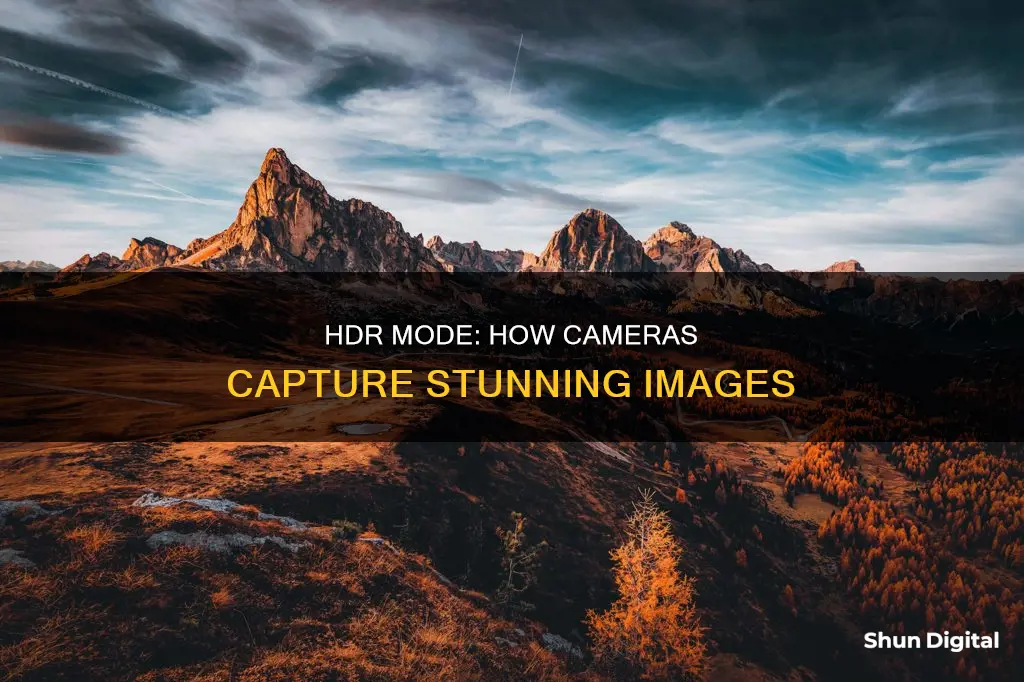
HDR, or High Dynamic Range imaging, is a photography technique that aims to add more dynamic range to photographs. Dynamic range refers to the ratio of light to dark in a photograph, and HDR photography aims to capture more detail in both the light and dark areas of an image. When used correctly, HDR can provide a visual treat, creating a more impressive picture that is closer to what the human eye can see.
| Characteristics | Values |
|---|---|
| Full Form | High Dynamic Range |
| Purpose | To improve image quality by adding more detail to light and dark areas |
| Dynamic Range | The range of luminosity between the brightest and darkest areas of a scene or image |
| Use Cases | Low-light and backlit scenes, landscapes, portraits in sunlight |
| Avoid Using | Scenes with movement, high-contrast scenes, vivid colours |
| Functionality | Captures multiple images with different exposures and combines them |
| Image Quality | Brighter highlights, better contrast, deeper and more realistic colours |
What You'll Learn
- HDR mode combines multiple photos at different exposures to create a single image
- It is useful for outdoor locations, landscapes, and interior real estate images
- It can be used to capture detailed, high-contrast photos of architectural subjects
- It is not suitable for moving subjects or high-contrast scenes
- It can be used to balance lighting in outdoor photos

HDR mode combines multiple photos at different exposures to create a single image
HDR stands for High Dynamic Range imaging. It is a photography technique that aims to add more "dynamic range" to photographs. Dynamic range refers to the ratio of light to dark in a photograph.
HDR mode combines multiple photos taken at different exposures to create a single image. This is achieved by taking the same picture multiple times, usually three, at different exposure levels. These photos are then combined to highlight the best parts of each photo. When using HDR on a smartphone, the device does all the work for you. It takes multiple pictures and combines them to produce a wide range of highlights, creating a more accurate representation of what you see with your eyes.
In the past, photographers would have to manually take multiple photos at different exposure levels and then use image editing software to blend the images together. Now, many cameras have a built-in HDR setting, which automates this process. This setting takes multiple photos but only shows you the result of blending all of them.
The HDR technique is particularly useful when you have trouble balancing the light in a photo, such as in landscape photography or when there is a lot of contrast between the sky and the land. It helps capture the details in both the highlights and shadows, creating a more dynamic image.
Understanding Bulb Exposure Mode in Photography
You may want to see also

It is useful for outdoor locations, landscapes, and interior real estate images
HDR, or High Dynamic Range imaging, is a photography technique that can help you take better-looking photos. It is particularly useful for outdoor locations, landscapes, and interior real estate images.
HDR aims to add more "dynamic range" to photographs by increasing the ratio of light to dark. It does this by taking multiple photos at different exposures and then blending them together to create a single image that captures more detail in both the light and dark areas.
When taking photos of landscapes or outdoor locations, HDR can help capture the details of where the sun is hitting, as well as the shadows. It can also help balance the exposure between the sky and the land, ensuring that neither looks too washed out or too dark.
For interior real estate images, HDR is useful because it mimics the way the human eye perceives light, creating a more natural-looking image. It can help balance bright and dark areas, such as when shooting through a window or door frame, resulting in a more realistic representation of the property.
However, it is important to note that HDR may not always be the best option. It can make photos with movement appear blurry and reduce the contrast in high-contrast scenes, making them less interesting. Additionally, it can wash out colours that are already vivid. Therefore, it is essential to experiment and determine when HDR will be most effective for a particular scene.
Activate Camera Mode: Rafting Tips and Tricks
You may want to see also

It can be used to capture detailed, high-contrast photos of architectural subjects
HDR, or High Dynamic Range imaging, is a photography technique that can be used to capture detailed, high-contrast photos of architectural subjects. It works by increasing the dynamic range of an image, or the ratio of light to dark, resulting in photos that more closely resemble what the human eye can see.
The human eye has a very high dynamic range, which is why we can see details in both shadows and highlights. Cameras, on the other hand, have a smaller dynamic range, making it more challenging to capture the same level of detail. This is especially true for architectural photography, where buildings and structures often have various hotspots and dark areas.
HDR mode improves on this by taking multiple photos (usually three) at different exposures and then combining them to create a single image with a greater dynamic range. This results in photos that capture more detail in both the shadows and highlights, creating a more accurate representation of the scene.
When shooting architecture, HDR can be particularly useful for capturing detailed, high-contrast photos that showcase the building's design and features. It can help bring out the textures and details that may otherwise be lost in shadow or washed out in highlights. By using HDR, photographers can create images that are more visually appealing and true to life.
However, it's important to note that HDR is not always the best option. In some cases, it can make photos look worse, especially when there are moving objects in the frame or when there is already a lot of contrast or vivid colours in the scene. Additionally, HDR images can sometimes look over-processed or unnatural if not done properly. Therefore, it's important for photographers to understand when and how to use HDR effectively to capture the best architectural photos.
Adjusting Your Camera: Master Similar Modes
You may want to see also

It is not suitable for moving subjects or high-contrast scenes
HDR, or High Dynamic Range imaging, is a photography technique that aims to add more "dynamic range" to photographs—where dynamic range is the ratio of light to dark in a photograph. It is particularly useful for low-light and backlit scenes, landscapes, and portraits in sunlight.
However, HDR is not always suitable for all types of photography. One situation in which HDR is not ideal is when photographing moving subjects. Since HDR involves taking multiple shots at different exposures and then blending them together, any movement between the shots can result in blurry or ghosted images. This is particularly noticeable when the majority of the image is composed of moving objects. While there are techniques to minimise the impact of movement, such as using a high shutter speed or masking in parts of the image, it can still be challenging to capture clear, sharp images of moving subjects with HDR.
Another scenario where HDR may not be the best choice is in high-contrast scenes. HDR aims to balance the light and dark areas of an image, which can result in a loss of contrast. In some cases, a strong contrast between light and dark areas can be desirable, such as when trying to highlight a dark shadow or silhouette. In these situations, HDR can make the image appear less interesting by reducing the intensity of the contrast.
Additionally, HDR may not be suitable for scenes with vivid colours. While HDR can enhance dull colours, it may also wash out or oversaturate colours that are already vibrant. It is important for photographers to consider the specific characteristics of the scene they are trying to capture and decide if HDR will enhance or detract from the final image.
Moto Z2's Dual Camera Mode: How Does It Work?
You may want to see also

It can be used to balance lighting in outdoor photos
HDR stands for High Dynamic Range imaging. It is a photography technique that can be used to balance lighting in outdoor photos.
Dynamic Range refers to the range of light and dark tones in a photograph. The human eye has a very high dynamic range, which is why we can see details in both shadows and highlights. Cameras, on the other hand, have a smaller dynamic range, and often struggle to capture the same amount of detail. This is where HDR comes in.
HDR mode works by taking multiple photos (usually three) at different exposures and then combining them to create a single image. The multiple exposures are typically one natural setting, and two that are overexposed and underexposed. By doing this, HDR aims to add more "dynamic range" to photographs, brightening dark areas without washing out the well-lit portions. This results in a more balanced image, with better lighting and more detail.
When taking photos outdoors, lighting can be a challenge, especially in landscapes, where there is often a lot of contrast between the sky and the land. HDR can be used to balance this discrepancy, ensuring that both the sky and the land are properly exposed and detailed, and creating a more accurate representation of what the eye sees.
It is worth noting that while HDR can be very useful for balancing lighting in outdoor photos, it is not always the best option. HDR can increase the chance of blurry photos if there is movement in the scene, and it can also reduce the contrast in high-contrast scenes, resulting in less interesting photos. Additionally, HDR can wash out colours that are already very vivid. Therefore, it is important to assess the situation and decide whether HDR will be beneficial or detrimental to the final image.
Understanding Raw Camera Format for Photography
You may want to see also
Frequently asked questions
HDR stands for High Dynamic Range. It's a photography technique that aims to add more "dynamic range" to photographs by taking multiple photos at different exposures and blending them together.
HDR mode is useful when you want to capture more detail in both the light and dark areas of a photo. It is particularly suitable for landscape photography, low-light scenes, and portraits in sunlight.
HDR mode is not suitable for capturing moving subjects or high-contrast scenes. It can also wash out vivid colours, so it may not be the best choice if you want to preserve strong colours in your photo.







